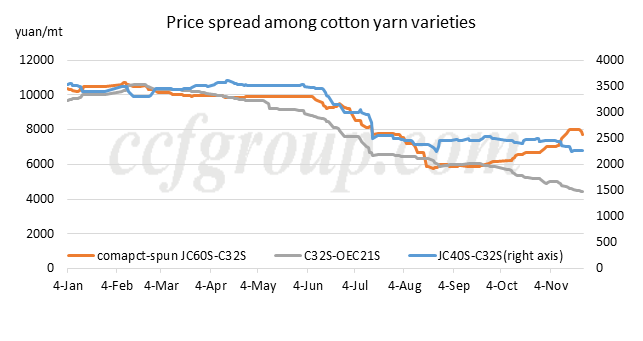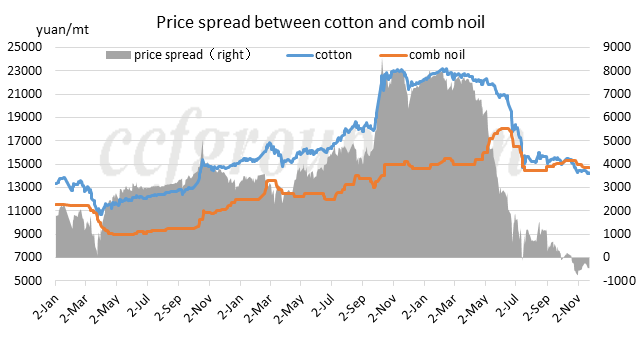Why price spread between combed yarn and carded yarn hits new low?
Overall cotton yarn market was weak since this year and cotton yarn prices went downtrend, but different varieties showed divergence in price. Low-count yarn trading was better than high-count yarn. It was obvious that carded yarn sales were better than combed yarn’s, which was shown greatly in cotton yarn price.

| C40S-C32S(yuan/mt) | JC32S-C32S | comapct-spun JC60S-C32S | C32S-OEC21S | |
| Prevailing range of price gap | Around 1000 | 2000-2500 | wide price gap | wide price gap |
| Highest point of price gap in 2021 | 1700 | 2945 | 12970 | 10600 |
| Lowest point of price gap in 2022 | 400 | 1250 | 5780 | 4300 |
| Current price gap | 820 | 1270 | 7800 | 4450 |
It can be seen from the above chart that the price spread between different varieties commonly reduced. The falling range of low-count yarn and carded yarn was smaller amid the dropping trend in 2022. The price spread between C40S and C32S reached around 1,000yuan/mt in previous year, it reached over 1,500yuan/mt in 2021 while the price spread narrowed to the lowest level within 500yuan/mt in 2022. Now the price spread was at relatively low level. The price spread between combed yarn and carded yarn was more obvious. The price spread commonly reached 2,000-2,500yuan/mt, it reached relatively high level 3,000yuan/mt in 2021, and reduced to current spread at around 1,300yuan/mt. The price spread between ring-spun yarn and open-end yarn reduced greatly. Price spread between C32S and OEC21S fell from 10,000yuan/mt in 2022 to 4,500yuan/mt now, and the falling range reached around 6,000yuan/mt. Price spread between compact-spun JC60S and C32S reduced from the highest point 13,000yuan/mt to the lowest level below 6,000yuan/mt, and the price spread reached around 8,000yuan/mt. So what cause such conditions?
1. The export demand for Xinjiang-origin combed and high-count yarn slipped amid the ban on Xinjiang cotton. China is a big textile and apparel export country with high proportion of cotton textile exports. The main consumption in destinations including Europe, US and Japan was high-leveled textile and apparel while the consumed products in countries of South Asia were lower-leveled. Countries in Europe and US imposed sanction on Xinjiang cotton, especially US, making the demand for Xinjiang-origin high-leveled combed and high-count yarn reduced obviously. On the contrary, the sales of imported cotton yarn were relatively good, and prices were obviously higher. The price spread between imported cotton yarn and Xinjiang yarn enlarged from 1,000yuan/mt at previous stage to more than 6,000yuan/mt now. However, domestic sales without the limitation on cotton origin and the products exported to South Asia took low-leveled carded yarn as main feedstock. The slip of demand led to faster price falling of combed and high-count cotton yarn.
2. Overall end consumption degraded amid the slip of economy. End consumption slowed down, slipped and even shrank, and consumption degradation appeared, which led to downstream traders’ lower requirement on cotton yarn quality. Instead of quality, they paid more attention to cheap price and lower cost. According to the reflection of cotton yarn mills and fabric mills, the procurement of many downstream clients degraded this year. For instance, some used compact-spun yarn to take place of combed yarn while others used open-end yarn to replace ring-spun carded yarn.
3. Cotton yarn imports shrank largely, and Chinese low-count yarn replenished that. The sales of low-count yarn were relatively good, and one of the important reasons of that was the great shrinkage of cotton yarn imports. In Jan-Oct 2022, cotton yarn imports only reached 958kt, reduced 764kt on year and the falling range reached 44.4%. Mainly sold variety of imported yarn was yarn with 32 counts and count number below that, and Chinese yarn replenished the shrinking part.
4. Comb noil prices were firm, making open-end yarn cost rise while combed yarn cost slipped. Meanwhile, the profit of combed yarn with the same count as carded yarn didn’t reduce due to the great falling of price. The profit of open-end yarn didn’t improve due to relatively firm price. Firm comb noil prices were mainly due to relatively good demand for open-end cotton yarn, making the supply of comb noil gradually tighten. However, the production of combed yarn reduced much due to bad demand. Comb noil had its own advantage when spinning to produce open-end yarn mainly because combed cotton was relatively pure and the consumption was lower than raw cotton, which was also one of the reasons for further price falling space of combed yarn and relatively firm open-end yarn price.


- Top keywords
- Cotton Price
- Cotton Futures Price
- Cotton Futures
- CZCE
- PTA Futures Price
- Chemical Fiber
- Polyester Prices
- Wool price
- PTA Futures
- Shengze Silk
- China
- Yarn Price
- price
- China Textile City
- Fibre Price
- Benzene Price
- Cotton
- Index
- Cotton Index
- PTA
- fabric price
- NYMEX
- Top 10
- textile industry
- Spot Cotton
- Cotton Yarn
- Polyester Price
- Futures
- PTA Price
- cotton yarn price

